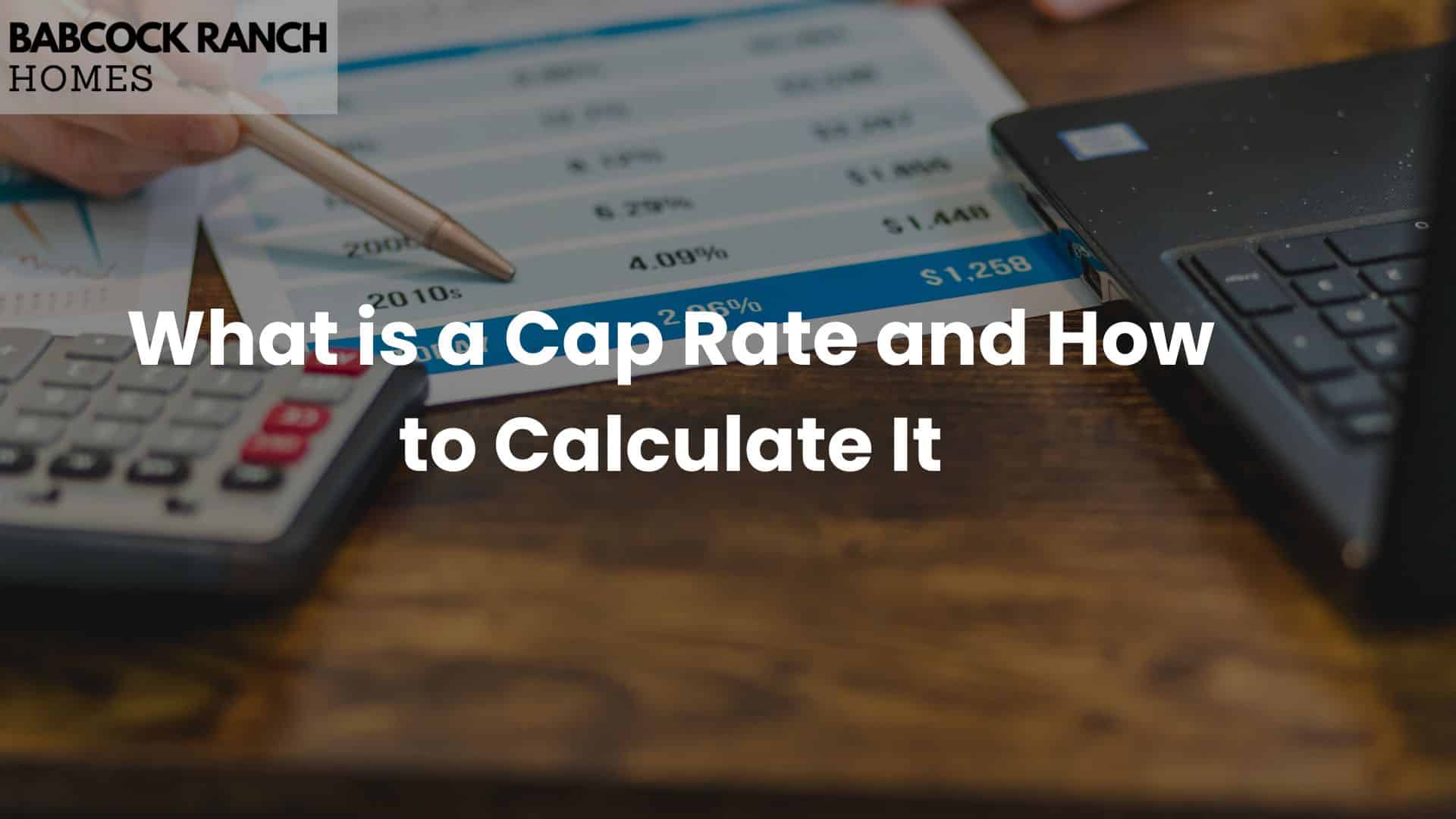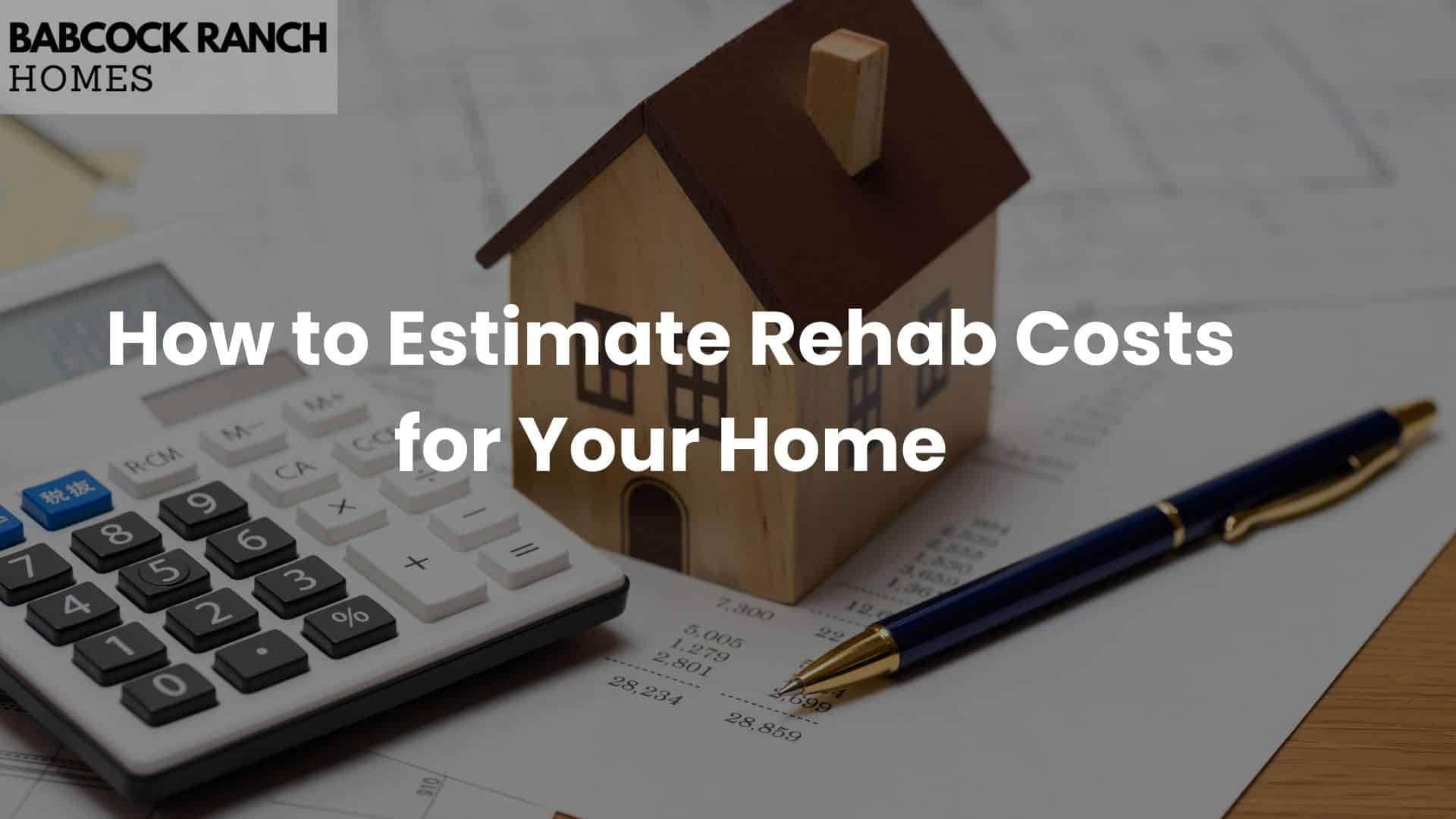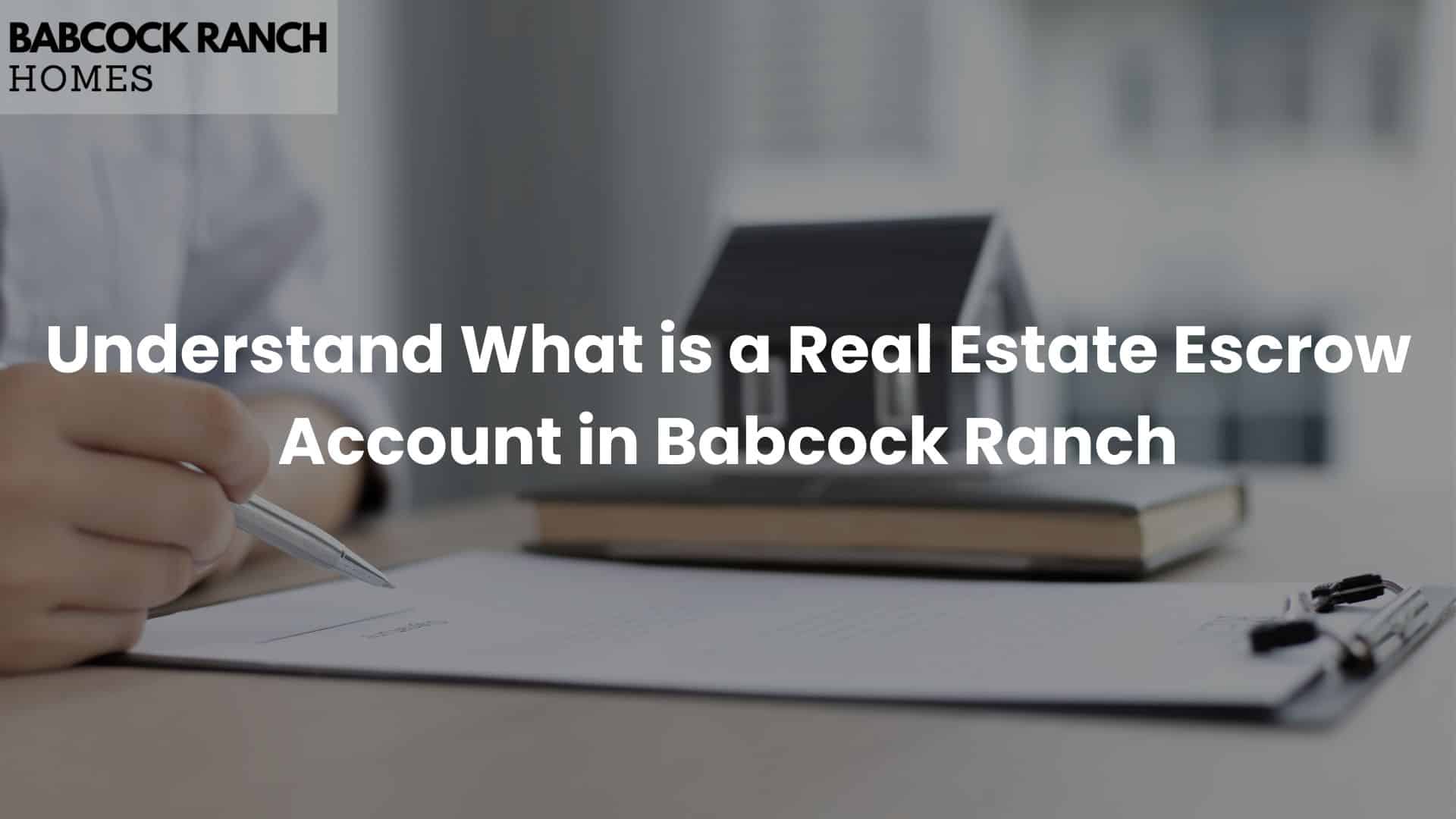
Investors seeking to maximize returns while minimizing immediate tax burdens often turn to IRS Section 1031. This provision allows swapping one investment property for another while deferring capital gains taxes. For those exploring real estateopportunities in Southwest Florida, Babcock Ranch Homes offers tailored guidanceto navigate these strategies effectively.
Under Section 1031 of the Internal Revenue Code, qualifying transactions let investors retain earnings that would otherwise go toward taxes. This approach supports portfolio growth by redirecting funds into higher-value propertyacquisitions. Whether upgrading commercial holdings or diversifying residential assets, understanding compliance requirements is critical.
Babcock Ranch Homes combines decades of local expertisewith in-depth knowledge of tax-advantaged investment methods. Their team helps clients identify like-kind exchanges, manage timelines, and align transactions with long-term financial goals. For personalized advice, call 518-569-7173 to connect with specialists familiar with Florida’s dynamic market.
Key Takeaways
- Tax-deferred swaps allow investors to postpone capital gains liabilities under IRS guidelines.
- Section 1031 applies exclusively to investment or business-related properties.
- Reinvesting proceeds into like-kind assets can accelerate portfolio growth.
- Local expertise ensures compliance with regional market trends and regulations.
- Babcock Ranch Homes provides actionable strategiesfor seamless exchanges.
Introduction to 1031 Exchanges
Navigating tax-deferred strategiesrequires understanding foundational tools like 1031 exchanges. These transactions let investors swap real estateholdings while postponing capital gains taxes, preserving wealth for future growth. By reinvesting proceeds into similar assets, individuals maintain momentum in expanding portfolios without immediate IRS obligations.
From Simultaneous Swaps to Modern Flexibility
Originally, these transactions required same-day trades—a logistical challenge. In 1979, the Starker v. United States case revolutionized the process, allowing delayed exchanges. This shift gave investors 180 days to finalize deals, making the strategy accessible to more portfolios. As one industry expert noted,
“The Starker decision transformed 1031 exchanges from niche to mainstream.”
Key Components for Compliance
Qualified intermediaries now play a vital role, holding funds securely during transitions. IRS rules mandate that replacement properties match the original asset’s purpose and value. Strict timelines—like identifying new holdings within 45 days—ensure transactions meet legal standards. Understanding these frameworks helps avoid costly missteps.
For investors, mastering this tool means balancing opportunity with regulatory precision. Later sections will explore timelines, depreciation considerations, and advanced exchange types to optimize outcomes.
Understanding what is a 1031 exchange
Property owners can strategically defer taxes by exchanging assets under specific IRS guidelines. This process applies only to holdings used for business or investment purposes, not personal residences. Two critical factors determine eligibility: the nature of the properties involved and adherence to tax deferral rules.
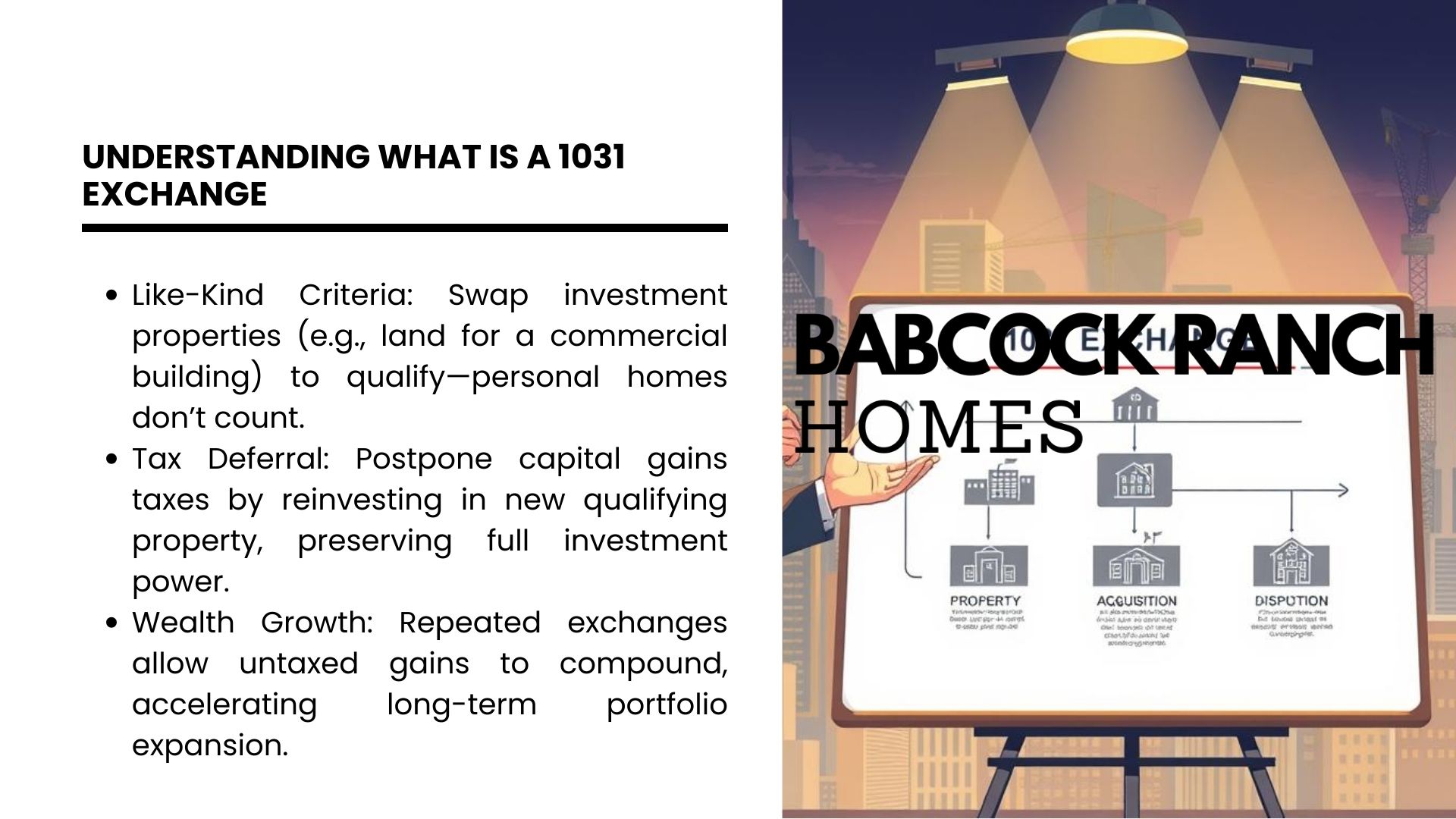
Defining Like-Kind Properties
The term “like-kind” refers to the nature of the asset, not its quality or condition. For example, a rental home can be swapped for a commercial building, or raw land for a multifamily complex. The IRS requires both the original and replacement property to serve similar investment objectives.
| Eligible Properties | Ineligible Properties |
|---|---|
| Rental homes | Primary residences |
| Commercial buildings | Stocks or bonds |
| Vacant land (held for investment) | Personal vacation homes |
Tax Deferral Benefits Explained
By reinvesting proceeds from a sale into a qualifying replacement property, investors postpone capital gains taxes. This preserves more capital for future growth. For instance, deferring $100,000 in taxes allows $500,000 to work in new investments instead of $400,000 after-tax.
The IRS permits unlimited deferrals if guidelines are followed. Taxes apply only when the asset is sold without another qualifying swap. Proper structuring ensures funds compound faster, creating long-term wealth-building opportunities.
The Mechanics of a 1031 Exchange
Executing a tax-deferred swap demands precise coordination with specialized professionals. Central to this process is the qualified intermediary, an independent third party tasked with holding proceeds and ensuring IRS compliance. Their involvement prevents investors from directly accessing funds, which could jeopardize the transaction’s tax-deferred status.
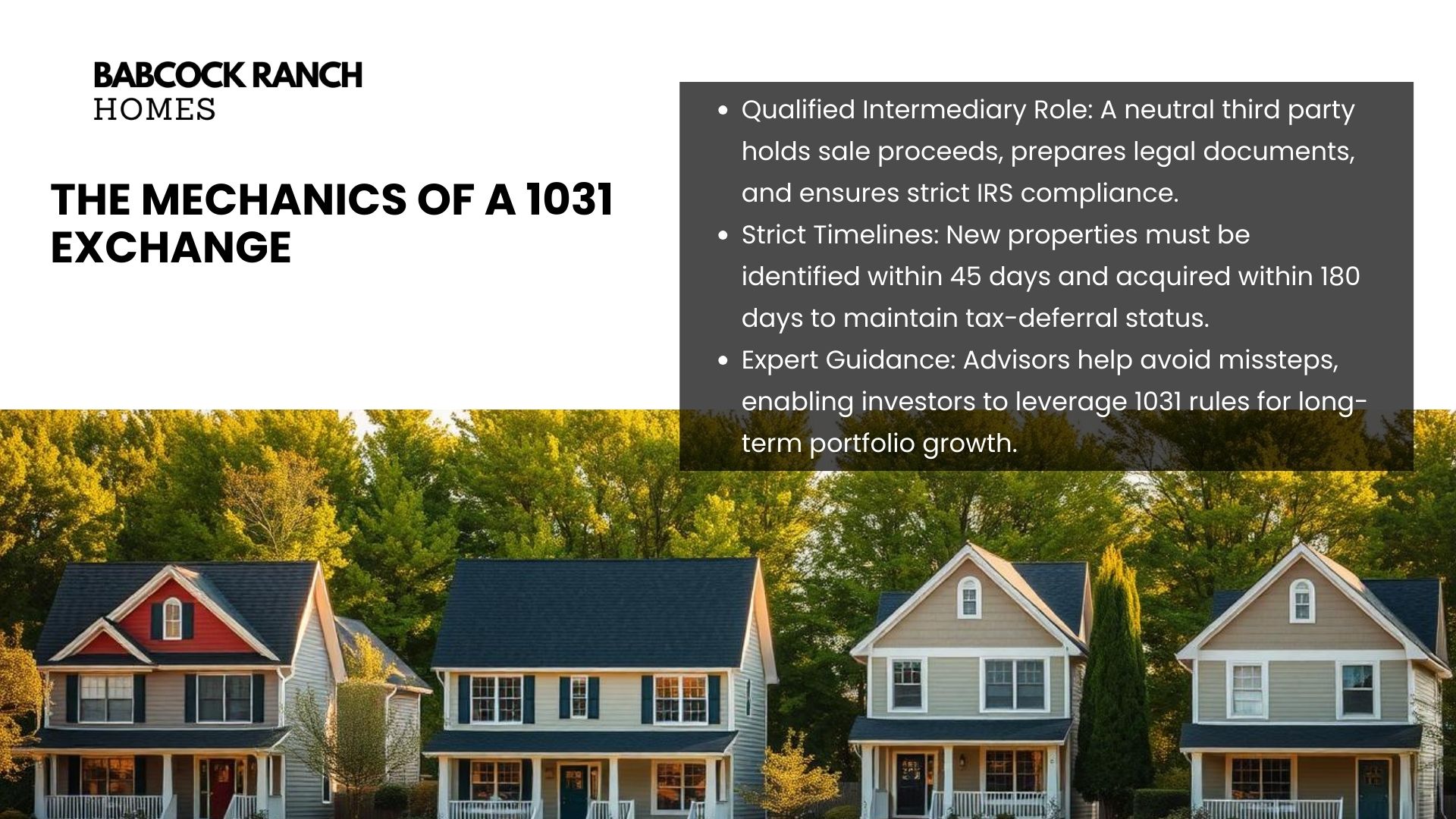
Role of the Qualified Intermediary
This professional oversees the entire exchange, safeguarding proceeds in a secure escrow account. Investors cannot receive sale funds—even temporarily—without triggering taxable events. The intermediary also prepares legal documents, tracks deadlines, and confirms replacement properties meet IRS criteria.
| Step | Action | Timeline |
|---|---|---|
| 1 | Seller transfers property to buyer | Day 1 |
| 2 | Intermediary holds proceeds | Until replacement closes |
| 3 | Investor identifies new asset | Within 45 days |
| 4 | Replacement purchase finalized | By day 180 |
Consider a scenario where an investor sells a rental property. The intermediary holds the $500,000 proceeds, allowing them to acquire a commercial building without tax penalties. As one tax attorney explains:
“An intermediary acts as the linchpin, ensuring all IRS requirements are met without direct taxpayer control over funds.”
Partnering with experienced advisors minimizes risks. They navigate complex regulations, verify replacement valuations, and maintain audit trails. This structured approach turns regulatory hurdles into opportunities for growth.
1031 Exchange Timelines and Deadlines
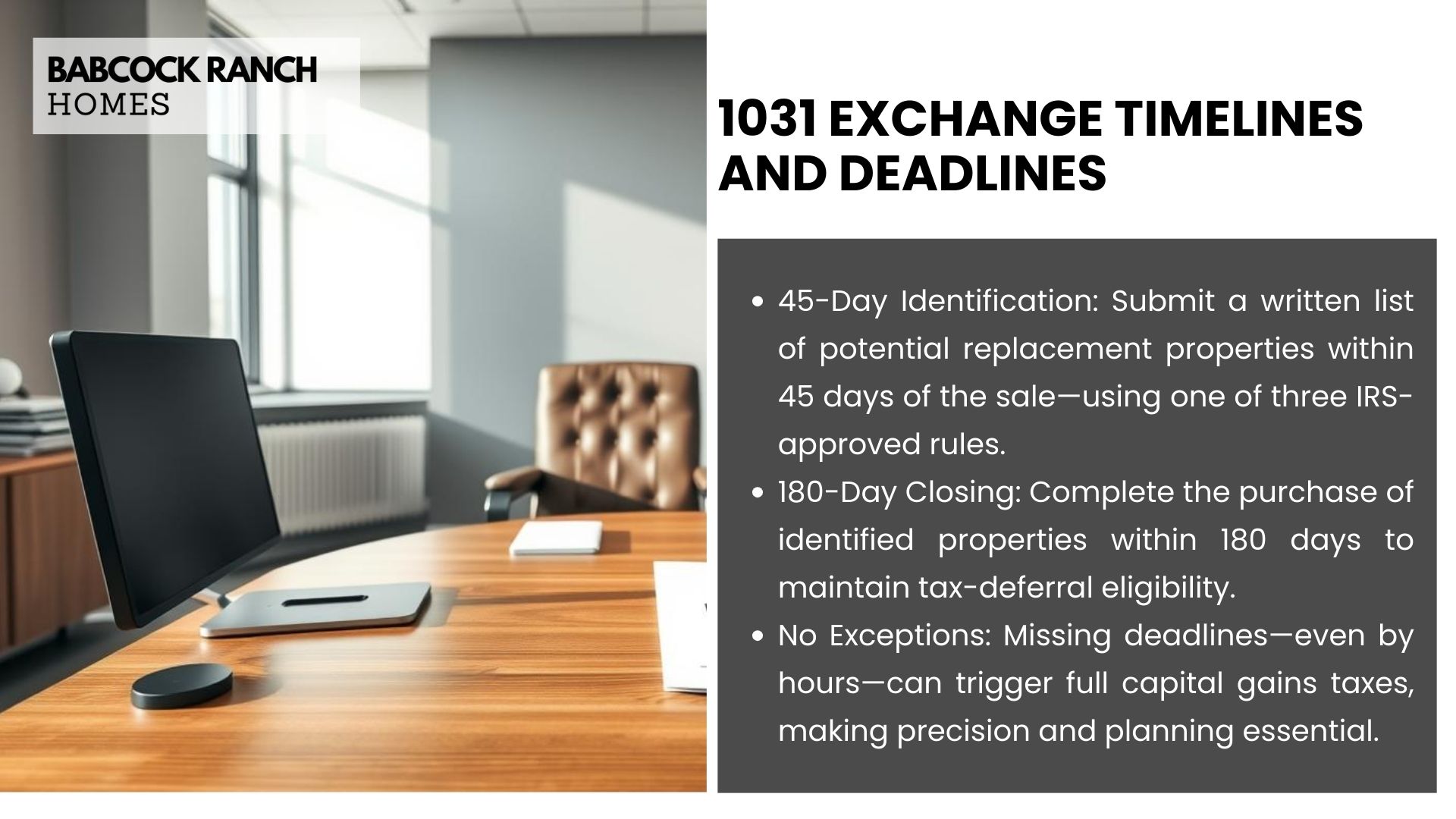
Meeting IRS deadlines is non-negotiable for preserving tax benefits in property swaps. Two critical timeframes govern these transactions: the 45-day identification window and the 180-day closing period. Both count from the sale date of the original asset, leaving no room for extensions.
45-Day Identification Period
Investors must formally identify potential replacement properties within 45 days. This requires submitting written documentation to all involved parties, including the qualified intermediary. The IRS allows three identification methods:
- Three-Property Rule: List up to three assets regardless of value
- 200% Rule: Identify unlimited properties if their total value doesn’t exceed 200% of the sold asset
- 95% Exception: List any number of properties if you acquire 95% of their combined value
180-Day Closing Rule
All replacement purchases must finalize by day 180. Missing this deadline invalidates the exchange, triggering immediate tax liabilities. A delayed closing risks forfeiting all deferred gains plus penalties.
| Deadline | Action | Key Points |
|---|---|---|
| Day 45 | Submit replacement property list | Notarized, unambiguous descriptions required |
| Day 180 | Complete replacement purchase | Funds must clear escrow by midnight |
One investor learned this the hard way:
“We missed day 180 by three hours due to a wire delay. The IRS denied our deferral—costing $82,000 in taxes.”
Use calendar alerts and legal checklists to track milestones. Partner with intermediaries who provide deadline dashboards and automated reminders.
Navigating Depreciation Recapture and Boot
Even successful property swaps can trigger unexpected tax liabilities if depreciation recapture or boot occurs. These technical aspects require careful planning to maintain full tax deferral benefits.

Managing Cash Boot and Debt Differences
Depreciation recapture applies when selling a property that’s been depreciated over time. The IRS taxes this portion at ordinary income rates—up to 25%—rather than lower capital gains rates. For example, a $300,000 sale with $80,000 in accumulated depreciation could face $20,000 in recapture taxes if not properly deferred.
Boot refers to non-like-kind assets received in an exchange, such as cash or reduced mortgage debt. This “extra” value becomes taxable immediately. Consider swapping a $500,000 rental home for a $450,000 commercial property. The $50,000 difference (cash boot) would incur taxes.
| Scenario | Taxable Boot? |
|---|---|
| Reinvesting all proceeds into equal-value property | No |
| Receiving $30,000 cash during exchange | Yes |
| New property has $75,000 less debt | Yes |
To minimize risks:
- Match or exceed original property’s debt and equity
- Work with accountants to calculate depreciation schedules accurately
- Use qualified intermediaries to structure debt transitions
“One client overlooked $18,000 in recaptured depreciation because their CPA used straight-line instead of accelerated methods. Proper planning saved them $4,500 annually.”
Regularly review depreciation records and align replacement debt levels. Partnering with tax professionals ensures compliance while maximizing deferred gains.
Rules and Regulations of Like-Kind Transactions
Adhering to IRS guidelines ensures tax-deferred status while avoiding costly penalties. The process demands strict alignment with Section 1031 requirements, from asset eligibility to documentation protocols. Even minor oversights can derail transactions, making compliance foundational to success.

IRS Guidelines and Compliance
Three core rules govern valid exchanges. First, both the original and replacement property must qualify as like-kind—meaning they serve comparable investment purposes. Second, the exchange must involve a qualified intermediary to hold proceeds without direct taxpayer access. Third, all transactions require detailed records proving adherence to timelines and valuation standards.
Common pitfalls include:
- Failing to identify replacement assets within 45 days
- Using sale proceeds for personal expenses before closing
- Mismatched debt levels between old and new holdings
| IRS Requirement | Noncompliance Risk |
|---|---|
| Like-kind asset type | Taxable event if properties differ in use |
| Equal or greater value | Partial taxation on undervalued replacements |
| Third-party intermediary | Disqualification if funds touch investor accounts |
As one IRS auditor noted:
“Most failed exchanges stem from poor documentation or rushed timelines—not malice.”
Work with legal advisors to draft ironclad contracts. Use escrow services that specialize in Section 1031 protocols. Verify replacement valuations through independent appraisals to meet all rules seamlessly.
Exploring Reverse, Delayed, and Improvement Exchanges
Beyond standard swaps, specialized exchange structures offer tailored solutions for unique scenarios. These advanced methods address timing challenges, portfolio diversification needs, and strategic upgrades.
Reverse Exchange Explained
In a reverse exchange, investors acquire replacement holdings before selling their original asset. This “buy first, sell later” approach requires a qualified intermediary to temporarily hold title to the new property. Unlike delayed exchanges, this method allows investors to secure desirable assets in competitive markets without missing deadlines.
When to Consider an Improvement Exchange
Improvement exchanges let investors upgrade replacement properties using tax-deferred funds. For example, purchasing raw land and adding infrastructure before completing the swap. This strategy works best when:
- Market conditions favor value-added renovations
- Original assets lack modern features limiting rental income
- Investors want to consolidate multiple properties into one upgraded asset
| Exchange Type | Key Benefit | Timeframe |
|---|---|---|
| Reverse | Secures inventory in hot markets | 180 days post-purchase |
| Improvement | Enhances property value pre-swap | Construction must finish within 180 days |
“Reverse exchanges let proactive investors act on opportunities without liquidating existing assets first.”
Intermediaries handle complex paperwork, including dual ownership agreements and construction escrows. Always consult tax advisors to confirm improvements meet IRS guidelines for like-kind status.
1031 Exchanges for Vacation and Investment Properties
Transitioning a vacation property into a revenue-generating asset requires careful alignment with IRS guidelines. Many owners discover they can repurpose personal retreats into income streams while deferring taxes—if specific criteria are met.

Converting Vacation Homes into Investments
To qualify for tax deferral, a vacation home must first become a rental property. The IRS requires owners to:
- Rent the asset at fair market rates for at least 14 days annually
- Limit personal use to 14 days or 10% of total rental days
- Maintain detailed records of income and expenses
For example, a coastal condo used three weeks yearly could generate $24,000 in annual rental income. After two years of documented leasing activity, it becomes eligible as replacement property in a swap.
| Personal Use | Investment Use |
|---|---|
| Family vacations | Year-round rentals |
| No income reporting | Schedule E tax filings |
“Owners often underestimate the two-year ‘seasoning period’ requirement. Proper documentation is key to proving investment intent.”
Benefits include deferring capital gains on appreciated value and redirecting equity into larger holdings. Work with appraisers to confirm fair market valuations before listing. Adjust rental strategies if occupancy rates fall below 60% to maintain compliance.
Tax Implications and Reporting Requirements
Accurate tax reporting forms the backbone of successful property swaps. Proper documentation ensures compliance with IRS guidelines while protecting deferred gains. Missteps in this phase can trigger audits or unexpected liabilities.
Essential Components of Form 8824
Every tax-deferred transaction requires filing IRS Form 8824. This document details the exchange’s dates, property values, and intermediary information. Key sections include:
- Descriptions of relinquished and replacement holdings
- Calculation of realized gains versus deferred amounts
- Confirmation of like-kind status and timelines met
Incorrect entries—like undervaluing replacement properties or misstating sale dates—can invalidate deferrals. One CPA recalls:
“A client omitted $220,000 in deferred gains by rushing through Section 3. The IRS assessed $55,000 in back taxes.”
| Documentation Checklist | Purpose |
|---|---|
| Closing statements | Verify sale and purchase dates |
| Intermediary agreements | Confirm fund handling compliance |
| Appraisal reports | Support property valuations |
Organize records chronologically and cross-reference them with Form 8824 entries. Tax professionals recommend starting this process within 30 days of closing to avoid deadline pressure. Digital tools like cloud storage and spreadsheet trackers simplify document management.
Consulting a certified tax advisor minimizes errors. They ensure filings align with current IRS interpretations while maximizing deferred benefits. Proactive reporting turns complex regulations into strategic advantages.
Estate Planning Benefits of 1031 Exchanges
Strategic property swaps offer more than immediate tax savings—they can shape generational wealth. By integrating real estate exchanges into estate plans, investors create opportunities for heirs to inherit assets with minimized tax burdens.
Stepped-Up Basis Considerations for Heirs
When heirs inherit a property through a 1031 exchange, they receive a stepped-up basis equal to its market value at the time of inheritance. This reset erases deferred capital gains taxes that accumulated during the original owner’s lifetime. For example, a $1 million property purchased for $300,000 would pass to heirs with a $1 million basis, eliminating $700,000 in potential taxable gains.
| Scenario | Original Basis | Heir’s Taxable Gain |
|---|---|---|
| No stepped-up basis | $300,000 | $700,000 |
| With stepped-up basis | $1,000,000 | $0 |
Key advantages include:
- Eliminating recapture taxes on depreciation deductions
- Preserving family wealth through multi-generational holdings
- Aligning investment strategies with long-term legacy goals
“Properly structured exchanges allow families to bypass decades of tax liabilities. We help clients design portfolios that benefit both current cash flow and future heirs.”
To maximize these benefits, coordinate with legal and tax professionals early. Document replacement property acquisitions clearly, and ensure estate plans reference exchange timelines. This proactive approach locks in advantages while maintaining IRS compliance.
Key Benefits for Property Investors
Building sustainable wealth through real estate demands strategies that amplify growth while minimizing tax erosion. Tax-deferred swaps unlock compounding potential, allowing portfolios to expand more aggressively than traditional sales permit.
Accelerating Portfolio Growth
By deferring capital gains taxes, investors reinvest 100% of their equity into higher-value assets. For example, redirecting $500,000 from a sale—instead of $400,000 after taxes—could fund a commercial property generating 25% more annual income. Over a decade, this difference compounds significantly.
Successful strategies often involve:
- Upgrading single-family rentals to multi-unit complexes
- Transitioning suburban land into mixed-use developments
- Leveraging market cycles to acquire undervalued properties
A recent study showed investors using these swaps grow portfolios 47% faster than those paying taxes upfront. As one portfolio manager observed:
“Deferred taxes act as interest-free loans from the IRS—smart investors use this capital to outpace competitors.”
| Strategy | 5-Year Equity Gain |
|---|---|
| Traditional Sale | $320,000 |
| Tax-Deferred Swap | $575,000 |
Babcock Ranch Homes specializes in identifying propertieswith strong appreciation potential. Their team analyzes local markettrends, zoning changes, and infrastructure projects to guide clients toward optimal swaps. This expertise proves critical during economic shifts, ensuring investments remain resilient.
Expert Advice from Babcock Ranch Homes

Navigating tax-deferred swaps demands precision, especially in fast-moving markets like Southwest Florida. Missteps in identifying replacement holdings or managing deadlines can turn potential gains into costly liabilities. Partnering with seasoned professionals ensures compliance while unlocking strategic opportunities.
Why Specialized Guidance Matters
Babcock Ranch Homes brings over two decades of experience structuring seamless transactions. Their team handles intricate details—from coordinating with qualified intermediaries to verifying replacement valuations. One investor shared:
“Their expertise saved us six figures in avoided penalties during a multi-property swap.”
Leveraging Local Market Knowledge
Florida’s real estate regulations and zoning laws require localized insights. The firm’s advisors track regional trends, including Babcock Ranch’s evolving mixed-use developmentsand infrastructure projects. This knowledge helps clients align swaps with high-growth opportunities.
Key advantages of working with their team:
- Customized strategies matching portfolio goals
- Proactive deadline management for 45/180-day rules
- Thorough audits of intermediary agreements
For tailored support, call 518-569-7173. Babcock Ranch Homes simplifies complex processes, letting you focus on long-term wealth building. Their commitment to clarity ensures informed decisions at every step.
Conclusion
Mastering tax-deferred strategiesempowers investorsto grow portfolios while preserving capital. By swapping eligible holdings through IRS-approved methods, you unlock compounding potential and avoid immediate tax burdens. Strict adherence to 45-day identification periods and 180-day closing rules ensures compliance.
Working with a qualified intermediary safeguards funds during transitions, while precise documentation meets regulatory standards. Replacement properties must align with original asset values and purposes to maintain deferred status. Local expertise proves invaluable when navigating regional market trends and zoning laws.
Babcock Ranch Homes specializes in structuring seamless transactions tailored to Florida’s dynamic real estate landscape. Their advisors simplify complex timelines, verify valuations, and optimize long-term wealth-building strategies.
Ready to explore how tax-deferred exchanges can elevate your portfolio? Call 518-569-7173 for personalized guidance. Let their team turn regulatory frameworks into opportunities for sustained growth.







